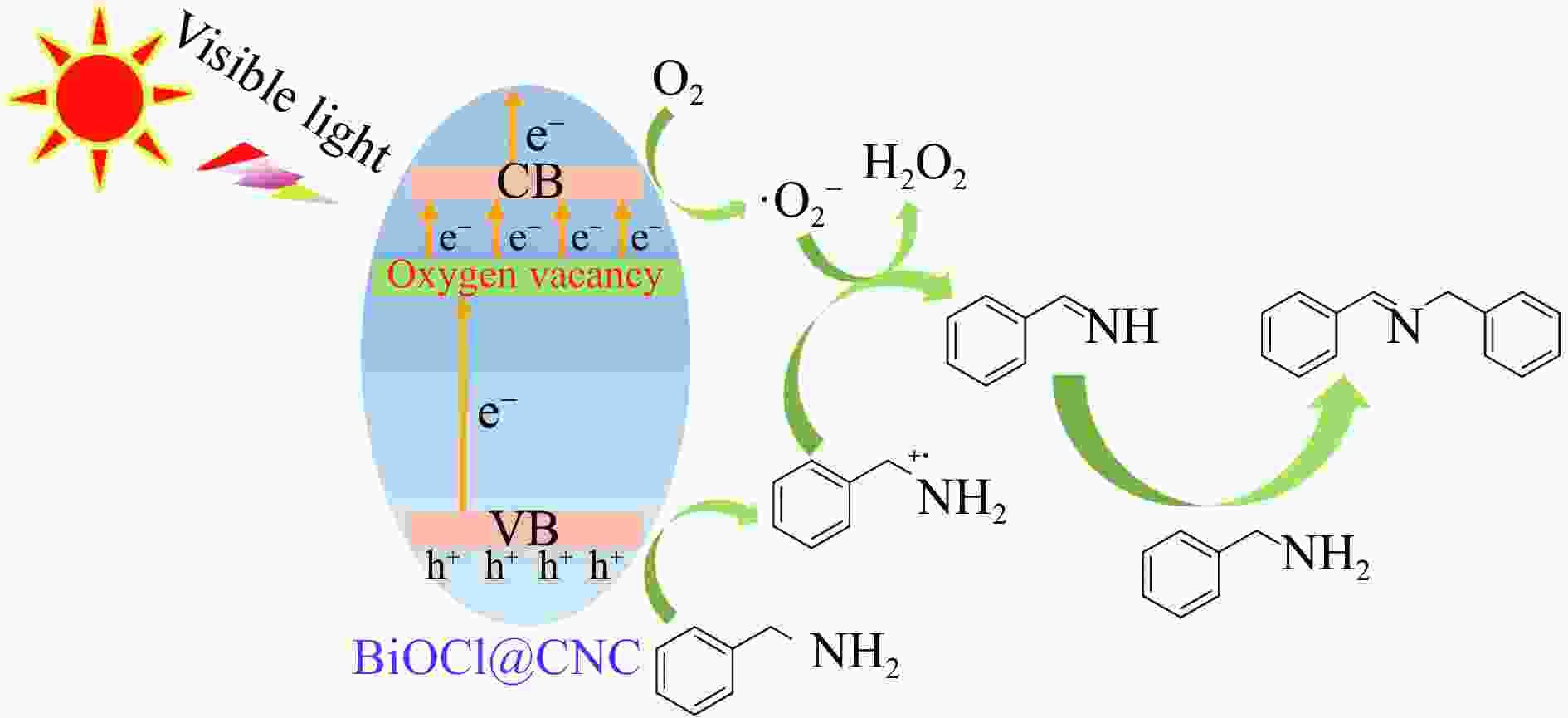Photocatalytic promotion of benzylamine C-N coupling by oxygen vacancies in bismuth oxychloride@nanocellulose composites
-
摘要: 本工作采用纳米纤维素(CNC)为载体,与BiOCl在室温搅拌下制备了复合光催化剂BiOCl@CNC。XRD、FT-IR、SEM、TEM、XPS等系列表征表明,CNC中大量羟基可以与BiOCl通过氢键紧密结合,并在材料中构造丰富的氧空位,从而显著提升其可见光催化性能。以可见光下催化苄胺C−N偶联为目标反应评估BiOCl@CNC的性能并对机理进行研究。首先对反应条件进行优化,得最优条件为1.0 mmol苄胺作为底物,20 mg BiOCl@CNC作催化剂,以30 W 白色LED灯为光源,在CH3CN中氧气氛围下室温反应20 h。底物扩展实验表明,BiOCl@CNC对含有不同取代基的反应物均表现出良好的适应性,且具有优异的稳定性。通过自由基捕获实验表明,电子在氧空位的辅助下产生超氧自由基,并与胺阳离子自由基中间体形成最终产物。这一工作不仅丰富了Bi基复合半导体的应用,也为N-苄烯丁胺的合成提供了新思路。Abstract: In this study, a composite photocatalyst BiOCl@CNC was prepared by simple stirring with BiOCl at room temperature using nanocellulose (CNC) as a carrier. Comprehensive characterizations (XRD, FT-IR, SEM, TEM, XPS) reveal that the abundant hydroxyl groups in CNC can form strong hydrogen bonds with BiOCl, leading to the creation of numerous oxygen vacancies in the material and thereby significantly enhancing its visible light-driven photocatalytic performance. The performance of the BiOCl@CNC was evaluated using the C-N coupling reaction of benzylamine as the target reaction under visible light, and the underlying mechanism was investigated. The results show that the optimal reaction process is that 1.0 mmol of benzylamine and 20 mg of BiOCl@CNC are added to CH3CN under an oxygen atmosphere to react for 20 hours using a 30 W white LED lamp as the light source. In the substrate expansion experiments, the BiOCl@CNC exhibits remarkable adaptability and exceptional stability towards reactants with diverse substituents. The free radical capture experiments demonstrate that the electrons can effectively generate superoxide radicals in the presence of oxygen vacancies and subsequently form the ultimate product through amine cation radical intermediates. This study not only expands the application potential of Bi-based composite semiconductors but also presents novel insights for synthesizing N-benzylene butylamine.
-
Key words:
- BiOCl /
- nanocellulose /
- oxygen vacancy /
- visible light catalysis /
- oxidation of benzylamine
-
表 1 反应条件的优化
Table 1 Optimization of reaction conditions
Entrya Cat. Solvent Light source Conv./%b 1 − CH3CN White LED 4 2 CNC CH3CN White LED 6 3 BiOCl CH3CN White LED 73 4 BiOCl@CNC CH3CN White LED 99 5c BiOCl@CNC CH3CN White LED 87 6d BiOCl@CNC CH3CN White LED 98 7 BiOCl@CNC (10 mg) CH3CN White LED 22 8 BiOC@CNC (15 mg) CH3CN White LED 91 9 BiOCl@CNC (25 mg) CH3CN White LED 97 10 BiOCl@CNC CH3CN Red LED 2 11 BiOCl@CNC CH3CN Blue LED 94 12 BiOCl@CNC CH3CN Green LED 7 13 BiOCl@CNC THF White LED 20 14 BiOCl@CNC DMSO White LED 10 15 BiOCl@CNC DMAc White LED 35 16 BiOCl@CNC C2H5OH White LED 8 17 BiOCl@CNC CH3CN/H2O White LED 16 a: Reanction conditions:benzylamine (0.1 mmol), catalyst (20 mg), slovent (4.0 mL), the reaction time was 20 h; b: The conversion rate was determined by the GC; c,d: The reaction time were 15 and 25 h, respectively. 表 2 反应底物适应性研究
Table 2 Substrate suitability studies
Entrya Substrates Products Conv./%b Sel./% 1 

99 ≥99 2 

88 98 3 

90 ≥99 4 

95 ≥99 5 

90 ≥99 6 

85 ≥99 7 

94 98 8 

66 ≥99 9 

43 ≥99 10 

81 ≥99 a: Reaction conditions:benzylamines (0.1 mmol), BiOCl@CNC (20 mg), CH3CN (4.0 mL); b: The conversion rate was determined by the GC. -
[1] MURAHASHI S I. Synthetic aspects of metal-catalyzed oxidations of amines and related reactions[J]. Angew Chem Int Ed,1995,34(22):2443−2465. doi: 10.1002/anie.199524431 [2] ZHAO C, GAO Y, ZHANG Z, et al. Functions of phytic acid in fabricating metal-free carbocatalyst for oxidative coupling of benzylamines[J]. Chin J Chem,2020,38(11):1292−1298. doi: 10.1002/cjoc.202000145 [3] CHE G, YANG W, WANG K, et al. Efficient photocatalytic oxidative coupling of benzylamine over uranyl-organic frameworks[J]. Inorg Chem,2022,61(31):12301−12307. doi: 10.1021/acs.inorgchem.2c01594 [4] PATIL R D, ADIMURTHY S. Catalytic methods for imine synthesis[J]. Asian J Org Chem,2013,2(9):726−744. doi: 10.1002/ajoc.201300012 [5] DUTTA B, MARCH S, ACHOLA L, et al. Mesoporous cobalt/manganese oxide: A highly selective bifunctional catalyst for amine-amine transformations[J]. Green Chem,2018,20(14):1−30. [6] LIU Y, HE Y, LI C, et al. Indium-vacancy-rich In2S3/Ni@C photocatalyst with chemical bonds for producing hydrogen and benzylamine oxidation[J]. Sep Sci Technol,2023,324:124571. [7] XIA Y, ZHU B, LI L, et al. Single-atom engineering of covalent organic framework for photocatalytic H2 production coupled with benzylamine oxidation[J]. Small,2023,19(35):2301928. doi: 10.1002/smll.202301928 [8] 赵立业, 李恒, 王亮, 等. 卤素原子对卤氧化铋 (BiOX, X = Cl、Br、I) 光催化性能的影响[J]. 燃料化学学报,2022,50(1):122−128.ZHAO Liye, LI Heng, WANG Liang, et al. Effect of halogen atoms on photocatalytic activity of bismuth oxyhalide (BIOX, X = Cl, Br, I)[J]. J Fuel Chem Technol,2022,50(1):122−128. [9] CUI J, TAO S, YANG X, et al. Facile construction of nickel-doped hierarchical BiOCl architectures for enhanced visible-light-driven photocatalytic activities[J]. Mater Res Bull,2021,138:111208. doi: 10.1016/j.materresbull.2021.111208 [10] SHEN T, SHI X, GUO J, et al. Photocatalytic removal of NO by light-driven Mn3O4/BiOCl heterojunction photocatalyst: optimization and mechanism[J]. Chem Eng J,2021,408:128014. doi: 10.1016/j.cej.2020.128014 [11] 黄宗益, 郑遗凡, 杨 娥, 等. 具有主导晶面的BiOIO3/BiOCl异质结制备与光催化性能[J]. 无机化学学报(中英文),2023,39(2):263−271.HUANG Zongyi, ZHENG Yifan, YANG E, et al. Preparation and photocatalytic performance of BiOIO3/BiOCl heterojunction with dominated facet[J]. Chin J Inorg Chem,2023,39(2):263−271. [12] HUANG T, TIAN F, WEN Z, et al. Synergistic mediation of metallic bismuth and oxygen vacancy in Bi/Bi2WO6-x to promote 1O2 production for the photodegradation of bisphenol A and its analogues in water matrix[J]. J Hazard Mater,2021,403:123661. doi: 10.1016/j.jhazmat.2020.123661 [13] QIU X Y, ZHANG Y, ZHU Y F, et al. Applications of nanomaterials in asymmetric photocatalysis: Recent progress, challenges, and opportunities[J]. Adv Mater,2021,33(6):2001731. doi: 10.1002/adma.202001731 [14] YANG G, LIANG Y, LI K, et al. Engineering the dimension and crystal structure of bismuth molybdate photocatalysts via a molten salt-assisted assembly approach[J]. J Alloys Compd,2020,844:156231. doi: 10.1016/j.jallcom.2020.156231 [15] CHEN F, MA Z, YE L, et al. Macroscopic spontaneous polarization and surface oxygen vacancies collaboratively boosting CO2 photoreduction on BiOIO3 single crystals[J]. Adv Mater,2020,32(11):1908350. doi: 10.1002/adma.201908350 [16] LIU Y, LI Y, LIU X, et al. In situ construction of rich oxygen vacancy Bi/Bi3TaO7 heterojunction photocatalysts[J]. Int J Hydrog Energy,2023,48(79):30664−30676. doi: 10.1016/j.ijhydene.2023.04.259 [17] ZOU P, LI Z, JIA P, et al. Enhanced photocatalytic activity of bismuth oxychloride by in-situ introducing oxygen vacancy[J]. Colloids Surf A Physicochem Eng Asp,2021,623:126705. doi: 10.1016/j.colsurfa.2021.126705 [18] WANG Z, CHEN Y, YIN M, et al. Construction of a PCN/Fe2O3/CdS double Z-type heterojunction photocatalyst and its application in the oxidative coupling reaction of benzylamine[J]. Dalton Trans,2021,50(27):9623−9636. doi: 10.1039/D1DT01459E [19] MOU Z, ZHANG H, LIU Z, et al. Ultrathin BiOCl/nitrogen-doped graphene quantum dots composites with strong adsorption and effective photocatalytic activity for the degradation of antibiotic ciprofloxacin[J]. Appl Surf Sci,2019,496:143655. doi: 10.1016/j.apsusc.2019.143655 [20] HAZIME R, FERRONATO C, FINE L, et al. Photocatalytic Degradation of imazalil in an aqueous suspension of TiO2 and influence of alcohols on the degradation[J]. Appl Catal B: Environ,2012,126:90−99. doi: 10.1016/j.apcatb.2012.07.007 [21] REHMAN S, ULLAH R, BUTT A M, et al. Strategies of making TiO2 and ZnO visible light active[J]. J Hazard Mater,2009,170(2):560−569. [22] ZHANG X, WANG XB, WANG LW, et al. Synthesis of a highly efficient BiOCl single-crystal nanodisk photocatalyst with exposing 001 facets[J]. ACS Appl Mater Interfaces,2014,6(10):7766−7772. doi: 10.1021/am5010392 [23] MA D, ZHONG J, LI J, et al. Enhanced photocatalytic activity of BiOCl by C70 modification and mechanism insight[J]. Appl Surf Sci,2018,443:497−505. doi: 10.1016/j.apsusc.2018.03.018 [24] WANG X, LIU X, LIU G, et al. Rapid synthesis of BiOCl graded microspheres with highly exposed (110) facets and oxygen vacancies at room temperature to enhance visible light photocatalytic activity[J]. Catal Commun,2019,130:105769. doi: 10.1016/j.catcom.2019.105769 [25] BELLAMKONDA S, RANGA R G. Nanojunction-mediated visible light photocatalytic enhancement in heterostructured ternary BiOCl/CdS/g-C3N4 nanocomposites[J]. Catal Today, 2019, 321–322 : 18–25. [26] LI Y, LIU Y, LIU X, et al. One-step synthesis of CdS/BiOCl: Efficient visible light reactive photocatalysts with Z-scheme heterogeneous structure[J]. J Mater Sci,2023,58:5574−5586. doi: 10.1007/s10853-023-08358-x [27] WANG X, LI X, TIAN B, et al. Immobilization of bismuth oxychloride on cellulose nanocrystal for photocatalytic sulfonylation of arylacetylenic acids with sodium arylsulfinates under visible light[J]. Arab J Chem,2022,15(5):103708. doi: 10.1016/j.arabjc.2022.103708 [28] LI H, CHEN S, SHANG H, et al. Surface hydrogen bond network spatially confined BiOCl oxygen vacancy for photocatalysis[J]. Sci Bull,2020,65(22):1916−1923. doi: 10.1016/j.scib.2020.06.013 [29] WU S, YU X, ZHANG J, et al. Construction of BiOCl/CuBi2O4 s-scheme heterojunction with oxygen vacancy for enhanced photocatalytic diclofenac degradation and nitric oxide removal[J]. Chem Eng J,2021,411:128555. doi: 10.1016/j.cej.2021.128555 [30] MA Z, LI P, YE L, et al. Oxygen vacancies induced exciton dissociation of flexible BiOCl nanosheets for effective photocatalytic CO2 conversion[J]. J Mater Chem A,2017,5(47):24995−25004. doi: 10.1039/C7TA08766G [31] LI H, LI J, AI Z, et al. Oxygen vacancy-mediated photocatalysis of BiOCl: Reactivity, selectivity, and perspectives[J]. Angew Chem Int Ed,2018,57(1):122−138. doi: 10.1002/anie.201705628 [32] KONG D, FAN H, YIN D, et al. AgFeO2 nanoparticle/ZnIn2S4 microsphere p-n heterojunctions with hierarchical nanostructures for efficient visible-light-driven H2 evolution[J]. ACS Sustainable Chem Eng,2021,9(7):2673−2683. doi: 10.1021/acssuschemeng.0c07638 [33] LI Y-L, LIU Y, MU H-Y, et al. The simultaneous adsorption, activation and in situ reduction of carbon dioxide over Au-loading BiOCl with rich oxygen vacancies[J]. Nanoscale,2021,13(4):2585−2592. doi: 10.1039/D0NR08314C [34] WANG Y, WANG Q, ZHANG H, et al. CTAB-assisted solvothermal construction of hierarchical Bi2MoO6/Bi5O7Br with improved photocatalytic performances[J]. Sep Purif Technol, 2020, 242 : 116775. [35] WANG G, ZHANG S, LU H, et al. Montmorillonite helps BiOCl photodegradation of antibiotics[J]. Environ Sci: Nano, 2023, 10 (12): 3423−3438. [36] ZHANG G, LV P, ZHAO P, et al. Facile microwave-assisted synthesis of In2O3 nanocubes and their application in photocatalytic degradation of tetracycline[J]. RSC Adv,2018,8(52):29578−29582. [37] MAKOLA LC, MOENO S, OUMA CNM, et al. Facile fabrication of a metal-free 2D–2D Nb2CTx@g-C3N4 MXene-based Schottky-heterojunction with the potential application in photocatalytic processes[J]. J Alloy Compd, 2022, 916 : 165459. [38] KHAMPUANBUT A, SANTALELAT S, PANKIEW A, et al. Visible-light-driven WO3/BiOBr heterojunction photocatalysts for oxidative coupling of amines to imines: Energy band alignment and mechanistic insight[J]. J Colloid Interface Sci,2020,560:213−224. doi: 10.1016/j.jcis.2019.10.057 [39] WANG P, LI X, FAN S, et al. Piezotronic effect and oxygen vacancies boosted photocatalysis C-N coupling of benzylamine[J]. Nano Energy,2021,83:105831. doi: 10.1016/j.nanoen.2021.105831 [40] PHASAYAVAN W, JAPA M, PORNSUWAN S, et al. Oxygen-deficient bismuth molybdate nanocatalysts: Synergistic effects in boosting photocatalytic oxidative coupling of benzylamine and mechanistic insight[J]. J Colloid Interface Sci,2021,581:719−728. doi: 10.1016/j.jcis.2020.07.140 [41] ZHANG S, QIAN X, YAN J, et al. Nickel-decorated g-C3N4 hollow spheres as an efficient photocatalyst for hydrogen evolution and oxidation of amines to imines[J]. New J Chem,2020,44(27):11710−11719. doi: 10.1039/D0NJ01218A [42] WANG X, LI X, WANG X, et al. Immobilization of bismuth oxychloride on cellulose nanocrystal for sunlight-driven superior photosensitized degradation[J]. Int J Biol Macromol,2022,206:398−408. doi: 10.1016/j.ijbiomac.2022.02.159 [43] SHUI Ying, CAO Rong. Boosting photocatalytic oxidative coupling of amines by a Ru-complex-sensitized metal-organic framework[J]. J Catal,2019,378:248−255. doi: 10.1016/j.jcat.2019.08.038 [44] HUANG J, HUANG Z, XU S, et al. Photocatalytic oxidative coupling of benzylamine to schiff base over 0D/2D CdS/CdIn2S4 heterojunction[J]. Energy Technol,2022,10:2200362. doi: 10.1002/ente.202200362 [45] HUANG Z, ZHANG Q, MA X, et al. Construction of 0D/1D CdS/g-C3N4 Z-scheme heterojunction for highly selective photocatalytic benzylamine oxidative coupling[J]. Mater Today Chem,2023,29:101475. doi: 10.1016/j.mtchem.2023.101475 -





 下载:
下载:












